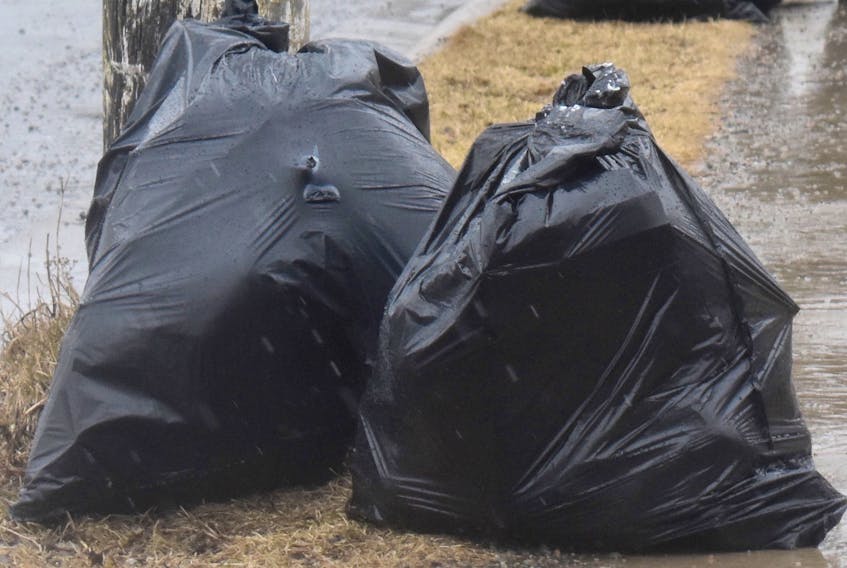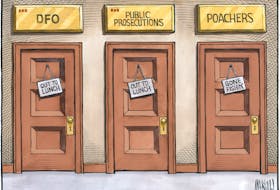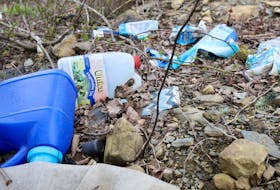NEW ALBANY, N.S. — What to do about the bears? That’s what folks in New Albany are wondering. But resident Heidi Alexander said it’s a people problem as much as it’s a bear problem because garbage is what’s attracting them.
In a packed-to-the-last-seat community meeting at the church on July 4, Annapolis County officials met with local residents – permanent and seasonal alike -- to try to deal with their concerns and talked about ongoing efforts to come up with a solution.
County CAO John Ferguson was at the meeting and in an interview said it boils down to people looking after their garbage, making sure it’s clean, and only putting it out on collection day. But the county has a number of initiatives in the works that might help.
A big problem is cottages on private roads where garbage trucks aren’t allowed to go, Ferguson said. And even if they could, some roads aren’t big enough to accommodate the trucks.
Some cottagers and Air BnB renters have been bringing their garbage and organics out before collection day. The waste can sit for as long as two weeks getting smellier and smellier and attracting bears as it rots. Compounding the problem is other people using those bins to get rid of their garbage.
The bears don’t care. They just like the easy access to grub, and Ferguson said as long as it’s there, the bears will come.
BIOLOGIST
That’s a sentiment echoed by Mike Boudreau, wildlife human conflict biologist with the Department of Lands and Forestry based out of Kentville.
He said there have been reports of problem, or nuisance bears in both Kings and Annapolis counties this year – and road kills of bears. He said the number of sightings is about average so far.
“It is early, and they will slow down a little bit and then they’ll pick up again, so it’s hard to say what level they will reach, but certainly up until now it’s been a regular year,” he said. “And when I say ‘regular’ I mean the same number of reports and calls on them.”
He said with berries ripening and other food sources coming on, bears will change their focus to the more abundant grub.
“They are very, very food motivated,” he said. “When they wake up in the morning, that’s what they’re thinking about – ‘where I’m going to eat, what I’m going to eat, how do I get to it’ – and they’ll travel a fair distance. They live and die by their nose. They have a very keen sense of smell.”
And it’s quite a nose. They can smell food more than a kilometer away. They love crops like blueberries, corn, soy beans, and even winter wheat, Boudreau said. And they love garbage.
GARBAGE WOES
Alexander said that in the past two summers bears have moved into the neighbourhood as garbage has become a welcome food supply.
“This poses a huge safety risk and brings with it a heated debate about possible trapping of our uninvited guests,” she said in a report from the July 4 meeting. “There has always been a widespread rumour that problem bears are being trapped in the Valley and then relocated to our area.”
Boudreau acknowledged that relocating bears is a department practice, but is rarely used.
“That is a policy,” Boudreau said. “It has been done in the past. Bears tend to be live-captured and those bears that are not aggressive, and/or are not considered a threat to human safety have been moved out to more wilderness areas. In the Valley area they would tend to go into the Tobeatic. Having said that, I think in the last 10 years there’s been four.”
He said moving bears is a last resort.
He said he doesn’t know the number of bears that have been destroyed, but said it would be more than the number captured and released.
Alexander said it can only be assumed that problem bears will be euthanized. “So a trapped bear is basically the same as a dead bear,” she said. That’s not something she wants to see happen.
PROBLEM COMPOUNDED
Alexander said in the past few years there has been an influx of new properties, cottage owners, and Air BnB renters, theoretically increasing the amount of garbage.
“At the same time our communal cottage bins have halved in size or been eliminated altogether,” she said. She said bear-proofed steel bins on private roads intended for the use of particular cottagers are being filled by other people, compounding the problem.
And there’s a common belief that logging activities in the area have been robbing bears of their natural habitat.
Boudreau said it might be the other way around. He believes clear cuts would tend to attract bears, not deter them, because over the years of regeneration they are prime food supplies – from insects and berries to new hardwood shoots, buds, and even leaves. Bears are omnivores, meaning they eat both meat and plants, but are mainly ‘vegetarian,’ Boudreau said. He cautioned however that bears are predators and will eat carrion and more – including rotting meat in garbage bags or green bins.
“While most of us have been putting up with irritating eyesores for years the bear problem cannot be ignored,” Alexander said. “Our garbage has become an open invitation to wildlife. While the bears have always been in our area and they have happily kept to themselves, they are now flocking to the McGarbage walk-through restaurant on a regular basis.”
A NEED
Ferguson said if you choose a private road as a place to live, you’ve basically chosen to live where there’s no service.
“But with that said, the county sees it as a need, and as a courtesy is willing to continue on with the bins,” he said. “But from the point of when it leaves someone’s home and gets to the bin, that’s really the responsibility of the community. We have no control over the behaviour of the homeowner. All we can do is say ‘look, these are the best practices.’ All the other residents who live in the county, who live on serviced roads, they can only put their garbage roadside on the day of collection. It’s a breach of the bylaw if you don’t follow that.”
He said some cottage owners are bringing their garbage out before the day of pickup. “Other homeowners can’t do that.”
Despite that, Ferguson said the county passed a motion July 9 to allow for the purchase of upwards of 10 large, three-sectional bins using gas tax rebate money. He said that many may not be needed, but he said council knows of some difficult areas and they will send the bins out.
SIGNS
“We also said we’d build some signs – best practice signs for the citizens in the cottage areas – and we are going to send them a template of what that will be and they can give us some feedback,” he said. “Ultimately we’ll hold the final say of what the signs will say.”
He said residents will receive copies of the bylaw and the collection schedules, and said the county would come back and hold follow-up meetings. Even putting up surveillance cameras is in the plans, Ferguson said.
Besides the meeting in New Albany, the county met with residents in the Grand Lake area on Highway 8. He said residents there recognized that it was their responsibility -- even to keep the bins clean.
The CAO said ultimately, when it comes to bears it’s all about safety. “That should be our No. 1 focus, but we have to do it together because otherwise it’s not going to work,” Ferguson said. “There are simple solutions but people have to agree to them.”
ENCOUNTERS
“Some scared residents had unpleasant encounters and shouted blue murder,” said Alexander in her report. “Killing the bears would only solve our problem short term but not tackle the root cause. Most people will agree that we have invaded bear territory and are causing the problems with our own carelessness.”
She said bears and other wild animals have always been part of North America and its ecosystem.
“Getting rid of our wildlife and taking the kids to the zoo instead is definitely not the solution,” she said.
“Making sure that we don’t attract trouble to our neighbourhood is the first step,” she said. “A fed bear is a dangerous bear that cannot be rehabilitated while a wild bear will usually mind its own business.”









